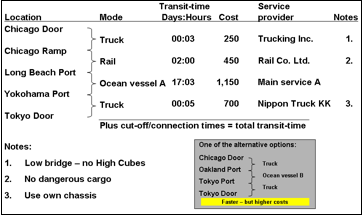Most airlines, bus and rail companies have it – but many container lines don’t. But what is it and why is it so important?
Simply specify place of receipt and place of delivery, and get a listing of all routing combinations and possibilities the line is able (and willing) to offer to the market.
Or is it that simple? –an example:
- operation in 20 different countries by five different services - serving 30 ports (some direct and some via feeder)
- cargo is accepted to and from say 100 inland locations
- some connections between inland locations and ports are direct - some are by intermodal combining rail and truck
- some can be served in different ways - truck all the way, rail only or a combination of rail/truck (at very different cost)
- in some of the corridors only certain equipment size and type can be used
- in some certain cargo types are not allowed – or they may have weight or height restrictions
- depending on the mode of transport the cut-off or connect time may differ
|
➢ This will easily amount to 25.000 - 50.000 different routing possibilities – who can keep track of that manually?
Are you missing the overview?
 Here is what a solution should be able to cover:
Here is what a solution should be able to cover:
- By specifying only start and end location of the transport, as well as a desired date (departure or arrival), the intelligence will dynamically generate all likely possibilities of moving cargo between the two specified points with in the given time range - for which it will pick connections based on mode of transport, like vessels (ocean going and feeders), barges, trains, trucks
- All links/legs required to transport cargo between the two locations will be connected and thus representing the entire transport plan - and should take in to consideration all constraints and restrictions
- The schedules and contracts in which each link/leg has been found will also contain information about start/end date (and thus duration), cost and service provider for each link and leg
- Having the start and end date for each link/leg, it will also calculate the total transit time including idle/waiting time
- The transport plan will thus also contain all points and locations touched upon in the transport, and applicable costs at each location; like loading, discharge, container/equipment days x daily cost, costs for handling empty containers including empty positioning etc., will be captured from relevant cost tables and contracts
- The entire route will suggest the pricing (ocean freight and surcharges) and revenue will be calculated
|
Routing option details:

The objective is to provide a dynamically generated and centralized description of all transport, routing and service options (products) offered by the line in order to support and provide:
➢ For sales and commercial
- Customers, agents and staff detailed information about products offered (and by inference products not offered), including details such as transit times, cut-off times, service providers, restrictions, etc.
- Agents and staff information about the product cost (allowing contribution calculation) and routing options preferred (if more than one exists) by the line and its individual customers.
|
➢ For transport planning/execution and service delivery
- Automatic generation of detailed transport plans describing how the movement of a specific consignment can/will be delivered and allowing these plans to drive the operational processes responsible for the actual execution
- Track and trace - and provide ability to raise alerts when things are not going to plan
- Details to do impact analysis and automatic generation of alternative route/transport plan in case of deviations.
|
Apart from being the foundation for very detailed contribution calculations, transport planning and execution, and track and trace, it will also aid:
- Evacuation of empties
- Vessel re-nomination
- COD/change of destination
|
➢ All in all providing a much better overview.
Apart from having worked directly with software pertaining to this area, I have also made business requirements definition for routing and service networks and been advisor with main emphasis on topics related to definition and usage of routing generation and selection for a number of major lines.



